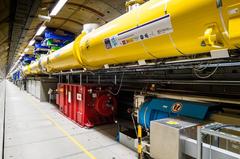URL: https://www.desy.de/news/news_search/index_eng.html
Breadcrumb Navigation
DESY News: Acceleration record at European XFEL
News
News from the DESY research centre
Acceleration record at European XFEL
The particle accelerator of the X-ray laser European XFEL has more than fulfilled the expectations placed in it. This is the balance drawn by the head of the European XFEL accelerator operation, Winfried Decking from DESY. Among other successes, the world's longest superconducting linear accelerator accelerated the planned record rate of 27,000 electron bunches per second for the first time in November, as Decking reported at the users meetings of the Hamburg X-ray light sources that kicked off on Wednesday.

View into the tunnel of the 1.7 kilometres long superconducting linear accelerator of the European XFEL. Credit: DESY, Dirk Nölle
The particle accelerator of the European XFEL is designed for a rate of 27 000 electron bunches per second, whereby 2700 bunches are grouped in a so-called bunch train. In November 2018, the accelerator physicists succeeded in accelerating ten such bunch trains per second and thus achieving this design parameter. “This has been the first time that bunch trains of this length have been accelerated in a long superconducting linear accelerator,” emphasised Decking. “Several of the predicted aspects of the beam dynamics could already be observed.”
For the research operation, that first started in September 2017, the number of electron bunches and thus X-ray flashes in the current year will be limited to a maximum of 6000 per second in order to be able to optimally set up and tune the still new measuring stations. However, this is still 50 times as many X-ray flashes as any other large X-ray laser can generate. The pulse rate of the European XFEL will then be increased to a maximum of 27,000 per second.
In addition to achieving the planned pulse rate, the particle accelerator of the European XFEL also reached the design energy of the electrons of 17.5 Giga electron volts (GeV) in 2018. All three existing light-generating undulator lines have been put into operation and supplied with electrons. In 2018, the accelerator has been operated for a total of 6800 hours, of which 1500 hours were for the first scientific experiments at the new facility. In the current year, the experiment time will be extended to around 4000 hours.
For the user meetings of DESY's X-ray light sources PETRA III and FLASH as well as of the European XFEL, around 1100 participants have registered this year. Until Friday, they will discuss new results, investigation possibilities and the further development of the research light sources. Around 80 companies will also be presenting their highly specialized products for cutting-edge research at an industrial trade fair.
User meetings: https://indico.desy.de/indico/event/21832/



